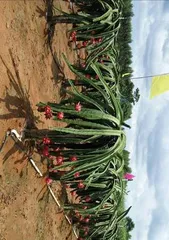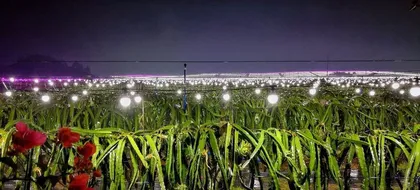Pitaya is an exotic fruit with delicate flesh and a refreshing taste, making it increasingly popular. However, in the cultivation process, how can one master the techniques for care and management during the fruiting period to ensure the quality and yield of the pitayas? Below is a detailed introduction.

Understanding the Fruiting Period of Pitaya
Before carrying out the care and management of pitaya, it is first necessary to understand its fruiting period. Typically, the flowering period of pitaya is from May to September, and the harvesting period is from June to November. Correctly understanding the fruiting period is the foundation for subsequent care and management.
Controlling Environmental Temperature
Pitaya is very sensitive to environmental temperature, with a suitable growth range of 20-30°C. Temperatures that are too high or too low will affect its flowering and fruiting. During the management process, it is important to control the environmental temperature, especially during the hot summer months, by strengthening ventilation and cooling to ensure the normal growth of pitaya.

Nutrient Supply
The nutrient supply for pitaya is crucial for its growth, development, and fruit quality. During the growth process of pitaya, timely fertilization is necessary to ensure an adequate supply of nutrients. During fertilization, attention should be paid to the rational combination of different types of fertilizers, and excessive fertilization should be avoided.
Pest and Disease Control
Pests and diseases are a major challenge in the growth of pitaya, as they not only reduce fruit quality but can also lead to issues like tree wilting. In the care and management of pitaya, it is important to promptly detect and control pests and diseases to ensure the healthy growth of the plant.
Creating a Suitable Growing Environment
Pitaya has relatively strict requirements for its growing environment, needing conditions such as ample sunlight, moderate humidity, and good ventilation. When caring for and managing pitaya, it is important to create a suitable growing environment, such as laying straw mats under the plants to provide sufficient shade and moisture retention.

Pruning
Pruning is an important step in the care and management of pitaya. Pruning not only controls the tree's shape and promotes the growth of lateral buds but also encourages flower bud differentiation and fruit development. However, when pruning, it is important to pay attention to the technique to avoid affecting fruit yield and quality.
Fruit Harvesting
Harvesting the fruits of pitaya is the final step in its care and management. Typically, when harvesting pitaya, select fruits that are brightly colored, round, smooth-skinned, and have thin skin and thick flesh to ensure their quality and taste. During the harvesting process, be gentle to avoid damaging the fruits.
Preservation and Storage
After harvesting, pitaya needs to be preserved and stored to extend its shelf life and maintain its taste. During preservation and storage, it is important to choose appropriate storage methods and temperatures, such as refrigeration or vacuum packaging.
Variety Selection
Different varieties of pitaya vary in fruiting period, fruit size, color, and other aspects. When caring for and managing pitaya, it is important to select varieties that are suitable for the local climate and soil conditions to improve fruit quality and yield.
Drainage Care
During its growth, pitaya needs to maintain moderate humidity, but excessive waterlogging can affect root health. When caring for and managing pitaya, attention should be paid to drainage, such as adding drainage ditches or improving soil permeability.
Ensuring Water Supply
Pitaya has a high demand for water, but overwatering can lead to waterlogged roots. When caring for and managing pitaya, it is important to control the amount and frequency of watering while ensuring an adequate water supply to ensure normal growth.
Pest and Disease Prevention and Control
Pitaya is susceptible to pests and diseases such as red spiders and piercing-sucking insects. When caring for and managing pitaya, it is important to promptly detect and control pests and diseases and choose appropriate control measures, such as spraying insecticides or improving ventilation.
Soil Improvement
Pitaya needs soil rich in organic matter to grow; conditions such as soil pH and aeration will affect its growth. When caring for and managing pitaya, it is important to improve the soil, for example, by adding organic fertilizers, lime, or other substances to enhance soil quality and promote plant growth.
Fruit Quality Inspection
Inspecting the quality of pitaya fruits is an important part of care and management. Typically, the color, size, and taste of the fruits should be inspected to ensure the quality and yield of the pitaya.
In summary, mastering the correct techniques for care and management during the fruiting period is crucial for ensuring the yield and quality of pitaya. When carrying out care and management, attention should be paid to aspects such as environmental temperature control, nutrient supply, and pest and disease prevention to create a rich and colorful fruiting experience for the pitaya.